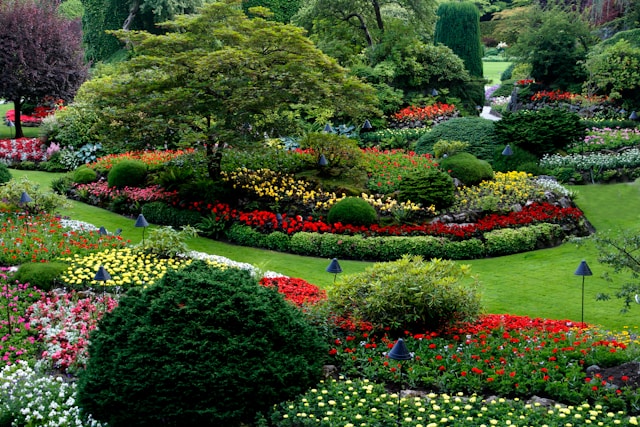Key Takeaways:
- Gain insight into the essentiality of regular and effective landscape maintenance and understand its role in promoting environmental sustainability.
- Use the right tools and adopt organic practices to ensure a vibrant, eco-friendly garden space.
- Discover water conservation strategies and seasonal care techniques to optimize the health and appeal of your outdoor space.
- Recognize the value of professional landscape maintenance services and what factors to consider when selecting a provider.
Table of Contents:
- Introduction to Landscape Maintenance
- Planning Your Landscape Maintenance Strategy
- Tools of the Trade: Essential Equipment for Landscape Maintenance
- Organic Gardening Practices in Landscape Maintenance
- Water-wise Landscaping and Maintenance Techniques
- Pruning and Plant Health Care
- Seasonal Maintenance Routines
- Transforming Your Space with Landscape Design Enhancements
- Hiring Landscape Maintenance Professionals: What to Look For
Introduction to Landscape Maintenance
Landscape maintenance is a task and an expression of love for the surrounding environment. The ongoing care guarantees the longevity and vibrancy of our outdoor spaces. Whether it’s a modest backyard or a sprawling estate, the grounds should serve as an extension of your home—a place for relaxation and enjoyment. Land clearing near me is an excellent starting point for anyone looking to take their outdoor space from underwhelming to magnificent. A well-maintained landscape provides aesthetic pleasure and contributes to the ecological balance of the local area, offering a sanctuary to an array of wildlife and bolstering biodiversity. But landscaping isn’t solely for the visuals; it has practical benefits too. A well-designed landscape can diminish noise levels, reduce air pollution, and even increase the value of your property. It also concerns the profound joy of tending plants and seeing them grow under your supervision. Transforming your land into a bountiful and serene haven is a meaningful journey that brings nature closer and offers a respite from the bustling world.
For homeowners eager to embark on the path of landscape maintenance, understanding the significance of each plant and feature in their outdoor space is essential. It’s not merely about keeping the lawn mowed or the hedges trimmed; it involves an ecological perspective that considers how each element interacts with the environment—a symphony of greenery in perfect harmony with nature.
Planning Your Landscape Maintenance Strategy
It takes careful planning and in-depth knowledge of the particular requirements of your outdoor space to develop an efficient landscape maintenance strategy. Consideration must be given to the local climate, the soil type, and the native plant species that thrive effortlessly within your region. For an effective strategy, one must adapt maintenance methods to align with seasonal changes and the life cycles of the plants. Seasonal planning, for instance, will dictate the timing for planting, pruning, and harvesting, ensuring that the landscape is maintained and thrives throughout the year. Part of a strategic landscape maintenance plan is learning about your region’s native plants and how they can be incorporated into your gardening efforts. Native species typically demand less upkeep as they are adapted to the local climate and are more resilient to local pests and diseases. They also play a critical role in supporting the local wildlife, offering natural habitats and food sources for various bird, insect, and mammal species. Hence, choosing the right plants is not just a matter of beauty; it is about cultivating an eco-friendly refuge that contributes to the local ecosystem.
Additionally, regular soil testing can save you a lot of headaches down the line. It helps identify your soil’s deficiencies and determines the appropriate amendments needed to boost its fertility. Fertile soil is the cornerstone of any flourishing landscape, providing plants with the essential nutrients they need to grow strong and healthy. Remember, the key to an exemplary landscape is not a one-size-fits-all approach but a personalized plan that caters to the unique aspects of your green space.
Tools of the Trade: Essential Equipment for Landscape Maintenance
A gardener’s toolkit is an extension of their hands, enabling them to sculpt and maintain the environment they care for. The choices are extensive, but every gardener should begin with the essentials. Quality hand tools such as spades, rakes, and shears are indispensable for daily tasks. These foundational tools help with planting, soil preparation, and regular upkeep. Investing in power tools like lawnmowers, hedge trimmers, or leaf blowers as your skills and garden grow can streamline the maintenance process, saving time and energy.
In today’s world, where environmental conservation is becoming increasingly paramount, equipping oneself with eco-friendly tools is a responsible choice. Such tools include rechargeable electric devices that run cleaner and quieter than gas-powered alternatives. They offer an earth-friendly solution without sacrificing performance. Additionally, manual tools like push reel mowers are resuming among eco-conscious gardeners looking to minimize their carbon footprint while attending to their lawns. An often overlooked but essential aspect of garden tools is their maintenance. A well-cared-for tool has a longer life and ensures that tasks are performed effectively and safely. Regularly cleaning and sharpening blades and properly storing tools away from the elements will prepare them for the next day’s work. The gardener’s ethos should be to care for the land and the tools that tend to it.
Organic Gardening Practices in Landscape Maintenance
Organic gardening is a holistic approach that considers the health of the soil, the plants, and the greater ecosystem. It focuses on growing plants without synthetic fertilizers, pesticides, and herbicides, relying instead on natural substances and processes that promote soil and plant health. While organic gardening may initially seem challenging, it is an empowering practice that aligns with the rhythms of nature and can transform any landscape into a thriving, alive environment. Taking steps such as using compost as a soil amendment, utilizing organic mulches, and planting companion species not only nourishes the soil but also encourages beneficial insects to take residence in the garden. These practices foster a delicate balance where pests and diseases are managed naturally. The growth among organic gardeners has been spurred by organizations like the American Society of Landscape Architects, which emphasize the value of sustainable design and practices in landscaping.
While the initial shift to organic methods can be an adjustment, the landscape health and longevity payoff cannot be overstated. Healthier soils lead to more robust, more resistant plants, creating more vibrant and enduring outdoor spaces. Compost and other organic matter added to the soil improves plant growth and helps sequester carbon from the atmosphere, which is a good thing in the fight against climate change.
Water-wise Landscaping and Maintenance Techniques
The thoughtful use of water is necessary in areas prone to drought and is an intelligent practice for any landscape. Xeriscaping, the method of designing landscapes to minimize the need for water, is becoming a prominent part of garden planning. Incorporating drought-tolerant plants, mulching, and using rain barrels to collect water can significantly reduce your garden’s thirst. Adequate irrigation methods can have a significant influence on water consumption. Understanding your landscape’s specific water needs—considering the type of plants you have and your soil’s moisture retention properties—can result in a lush garden that is a model of water efficiency. The importance of water conservation in garden practices is highlighted by resources from the Environmental Protection Agency, offering guidance for gardeners who wish to adopt water-smart techniques.
Mulching is another clever tactic for maintaining soil moisture. It conserves water by reducing surface evaporation and contributes to soil health by breaking down nutrients over time. Mulching can also suppress weed growth, which competes with your plants for precious water and nutrients. Regular monitoring of irrigation systems, upgrading when necessary, or making timely adjustments based on weather forecasts can further ensure that no drop of water is wasted while keeping your garden flourishing.
Pruning and Plant Health Care
Pruning is an art form in itself, a crucial part of landscaping that shapes not only the physical appearance of plants but also their health and growth patterns. Appropriate pruning encourages plants to develop a strong structure and can enhance the quantity and quality of flowers and fruits. It’s more than aesthetics; pruning removes dead and diseased wood, minimizing the risk of spreading pests and diseases throughout the plant or garden. Understanding the right time to prune is just as important as knowing how. Certain plants benefit from pruning in early spring, before the bud break, while others thrive when pruned after flowering. Observing your plants throughout the seasons and noting their growth habits will inform your pruning schedule. Moreover, using the right tools, such as sharp, clean secateurs and loppers, is essential, as they make clean cuts and help ensure a quick plant recovery.
Beyond pruning, plant health care involves a range of practices. It can include anything from adjusting soil pH to providing the proper nutrients and managing light exposure. Vigilance is vital—implementing regular check-ups for signs of distress, like unusual leaf discoloration or wilting, can catch potential issues early on. Taking a proactive stance on health care can help to maintain a vibrant and dynamic ecosystem within your garden.
Seasonal Maintenance Routines
Gardens are living entities that require different care as the seasons change, a fact often ignored and leading to most gardening woes. Spring invites planting and mulching, summer calls for vigilant pest management and watering, while autumn is the time for harvesting and preparing for the winter frost. Seasonal maintenance routines are more than chores—they ensure the survival and revival of your landscape through the ever-changing climatic cycle. Frequent soil aeration and amendments, such as replenishing mulch and assessing irrigation systems to meet changing demands, are part of this cyclic maintenance. Understanding that your landscape’s needs in the scorching heat of summer are vastly different from those of the dormant winter period is crucial. Each action, done with consideration for the time of year, will contribute to a robust and lively exterior. It’s also important to consider the timing of landscape enhancements or new installations, as planting in the wrong season can lead to failure before the plants even have a chance to establish themselves. Planning these activities with the seasons in mind will ensure their success and minimize maintenance requirements.
Transforming Your Space with Landscape Design Enhancements
A static landscape can benefit significantly from design enhancements that reflect the homeowner’s personality and the evolving seasons of life. Introducing new varieties of plants, integrating a water feature, or constructing an outdoor fire pit can dramatically alter the ambiance of your outdoor space. Enhancements such as these can make your landscape an ever-evolving canvas that reflects personal style and accommodates changing tastes or lifestyle needs. These creative endeavors can make your green space a valid extension of your home, reflecting personal aesthetics and functionality. While adding new elements to your landscape, balancing aesthetic desires with practical considerations is crucial. Features requiring significant maintenance or resources may be better for some homeowners. When planning enhancements, be realistic about the time and effort you can dedicate to upkeep. Striking a balance between beauty and maintenance requirements will ensure a functional and sustainable outdoor living area.
Every modification should also maintain cohesion with the existing landscape design. A well-thought-out plan for inserting new features or altering existing ones ensures that the overall integrity and harmony of the landscape are preserved. As with any improvement, these changes should be well-integrated into the current maintenance routine, enhancing, rather than hindering, the garden’s vitality.
Hiring Landscape Maintenance Professionals: What to Look For
There comes a point when maintenance tasks exceed the scope of a homeowner’s expertise or available time. It is when the skills of a professional landscape maintenance service become invaluable. Professionally trained teams possess the knowledge and equipment necessary to address complex landscapes and can perform tasks ranging from primary lawn care to intricate botanical treatments. When evaluating potential services, look for companies with credible references, a strong portfolio of completed work, and transparent pricing structures. Check to see if the services provided meet the needs of your landscape; some may specialize in specific maintenance tasks or provide packages that include routine visits along with a predetermined list of services. Selecting a company that values communication is also beneficial, providing regular updates and insights into your landscape’s care. A professional service that takes a holistic approach to your outdoor space can be a worthy investment, ensuring that your landscape is maintained and continues to flourish under expert care.
However, be cautious in your selection. Take your time to meet with potential service providers, discuss your vision for your landscape, and understand what they can offer. Recall that the objective is to build a lasting relationship with a supplier who values and comprehends your outdoor environment just as much as you do. By ensuring they give your landscape the best possible care and attention, you can help keep it healthy and beautiful for many years to come.




